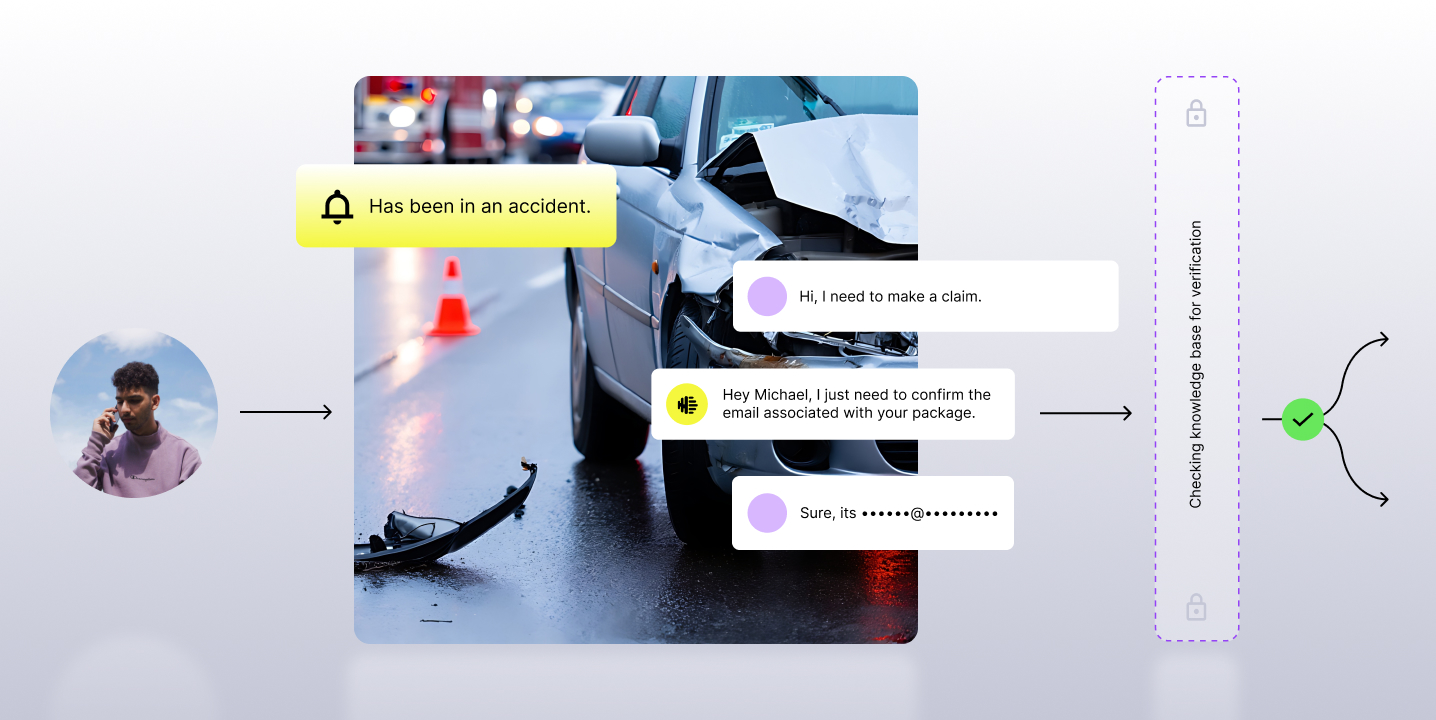In customer service, every second counts. Contact centers all over the world are facing growing pressure to handle more calls in less time while maintaining great customer experiences. Despite the high bar, using artificial intelligence (AI) in call centers has fundamentally transformed how human agents interact with callers, increasing efficiency without sacrificing quality.
As customer expectations continue to soar, the companies that will rise to the occasion are those that use AI solutions to optimize their call center operations and empower their teams with AI tools that make their jobs less stressful and more productive.
How AI Can Improve Call Centers
AI-powered call center solutions are upending contact center operations in the best ways possible. By supporting agents throughout the customer journey and streamlining what would otherwise be time-consuming workflows, call center agents can focus on value while the AI technology handles speed.
Rather than replacing live agents, contact center AI platforms and the advancements they offer work with the agent to tackle customer inquiries in the most effective, professional, and informative way possible. Strategically implementing AI and machine learning across your call center can dramatically reduce AHT while simultaneously improving the quality of the call and other industry benchmarks and KPIs.
Standard Calls vs. AI
Traditional calls often include lengthy authentication processes, multiple holds while agents search for information, and extended after-call work that limits the agent’s availability to take new calls. With voice-recognition verification, immediate resource retrieval, and automated transcription, AI reduces or outright eliminates these manual workflows, leading to less friction and happier customers.
Helps Agents During the Call in Real Time
Conversational AI platforms are designed with agents in mind, working alongside them, not in place of them, to reduce stress, ease cognitive load, and help them feel more confident in every interaction. They analyze customer interactions in real time using natural language processing (NLP), providing suggestions and relevant information exactly when agents need it. These agent-assist systems detect customer sentiment and intent, then automatically recommend the next best action to help resolve inquiries without lengthy searches or holds.
When customers ask tough questions or bring up complex issues, the AI platform instantly scans knowledge bases and similar previous calls to provide accurate answers. This helps create continuity between contact center agents and prevents customers from receiving different advice.
Takes Care of Tasks After the Call
AI systems listen to entire conversations and automatically generate comprehensive call transcripts and summaries so agents can focus fully on the next customer. This automation eliminates time-consuming repetitive tasks like manual note-taking and data entry, while also highlighting appropriate follow-up actions based on the conversation, such as sending confirmation emails or updating customer data.
Makes Daily Tasks Easier
AI-driven platforms help call centers consolidate information from multiple systems into a single, intuitive CRM interface and can be set to display only what’s most relevant to the current customer interaction.
Repetitive tasks and multi-step processes that previously required human oversight and manual entry can now be condensed into a simple, algorithm-based workflow. This allows agents to activate automated processes while keeping their focus on the customer conversation.
Spots Factors That Slow Down Calls
Advanced AI can evaluate thousands of calls, including sentiment analysis, customer intent, inquiry type, call location, and time of day, to identify common patterns that lead to extended handle times or frustrated customers.
When conversations begin to show signs of excessive length or complications, real-time insights can notify call center managers or provide immediate guidance to agents before calls get out of hand.
Sends Calls Directly to the Right Agent
Intelligent call routing with virtual agents can analyze a customer’s history and inquiry and direct each call to the most qualified available representative from the start. Natural language processing allows the system to understand why a customer is calling before they even speak to a live agent, leading to more accurate solutions, shorter call resolution time, and immediate problem-solving. Your customers won’t be needlessly bounced around, and your agents will be well-equipped for every incoming call.
Keeps Info Accessible to Agents
Knowledge bases powered by generative AI can instantly pull up relevant FAQs, policies, and procedures based on the ongoing conversation. When agents encounter unfamiliar situations and scenarios, the agent’s AI platform will jump in and provide step-by-step instructions to guide them through complex processes with on-screen information and talking points without disrupting the conversation with the caller.
The AI Technologies That Power Contact Center Improvements
The latest generation of AI-driven contact centers is possible thanks to a sophisticated technology stack that transforms customer service into intelligent, streamlined, and deeply personalized interactions.
These include:
- Large Language Models (LLMs): These systems are trained on massive datasets of text to understand and generate human-like responses with remarkable accuracy. LLMs serve as the cognitive backbone of modern contact centers, enabling complex reasoning, multi-turn conversations, and the ability to handle nuanced customer queries across virtually any topic.
- Natural Language Processing (NLP): At the heart of AI communication lies NLP—the technology that enables machines to understand, process, and produce human language across voice and text channels. Through sophisticated analysis of linguistic patterns and contextual cues, NLP empowers AI to hold fluid, natural conversations that feel genuinely human to both customers and support staff.
- Natural Language Understanding (NLU): A specialized subset of NLP, NLU focuses specifically on comprehending the meaning and intent behind customer communications. It goes beyond simple word recognition to grasp context, identify specific requests, extract key information, and understand the true purpose of a customer's message—whether they're asking a question, filing a complaint, or seeking technical support.
- Machine Learning (ML): The continuous improvement engine of AI systems, ML algorithms digest massive datasets including conversation transcripts, chat histories, and customer information. This ongoing learning process helps AI systems enhance their accuracy, adjust to emerging situations, and generate increasingly valuable insights as they evolve.
- Generative AI: This creates original content—from personalized email responses to detailed troubleshooting guides—based on customer needs and context. In contact centers, generative AI drafts tailored responses, produces dynamic knowledge articles, suggests solutions to agents in real-time, and even generates summaries of complex interactions.
- Speech Recognition: This technology transforms spoken words into digital text instantaneously, enabling AI to process, comprehend, and react to voice conversations as they happen. The result? Sophisticated capabilities including automated voice support and real-time assistance for human agents.
- Sentiment Analysis: This emotional intelligence layer interprets the underlying feelings, attitudes, and intentions in customer communications. By detecting customer emotions and identifying urgent situations, sentiment analysis enables contact centers to anticipate problems, tailor their approach, and provide genuinely compassionate support.
- AI-Enhanced Analytics & Reporting: Sophisticated analytical platforms harness AI to extract meaningful patterns from interaction data, monitor team effectiveness, and spot operational patterns. These intelligence-driven findings help leadership teams make informed strategic choices and fine-tune contact center operations across the board.
Top Use Cases for AI In Contact Centers
Automated Quality Assurance: Unlike traditional methods that review only small samples, AI enables automatic evaluation of every single customer interaction. This complete coverage identifies compliance issues and service quality gaps instantly, giving managers real-time visibility into coaching needs and performance trends across their entire team.
Smart Interaction Routing: By analyzing customer history, digital footprints, and previous touchpoints, AI connects each customer with the ideal agent for their specific situation. This intelligent matching dramatically improves first-contact resolution rates while minimizing transfers and reducing overall handle times.
Virtual Assistants (Voice & Chat): AI-powered chatbots and virtual agents deliver instant support across websites, apps, and messaging platforms 24/7. These digital assistants handle everything from simple FAQs to complex troubleshooting, intelligently escalating to human agents when situations require that personal touch—ensuring customers receive immediate help whenever they need it.
Real-Time Agent Assistance: AI acts as a virtual co-pilot for agents during live interactions, instantly surfacing relevant knowledge articles, suggesting next-best responses, and providing compliance reminders. This real-time guidance empowers even newer agents to handle complex situations confidently, reduces training time, and ensures consistent service quality across every interaction.
Automated Post-Call Summarization: AI automatically generates comprehensive interaction summaries, capturing key issues, resolutions, and follow-up actions within seconds of call completion. This eliminates time-consuming manual note-taking, ensures nothing falls through the cracks, and creates searchable records that help agents quickly understand customer history on future contacts.
Predictive Customer Churn Prevention: By analyzing behavioral patterns, interaction frequency, and sentiment trends, AI identifies customers showing early warning signs of dissatisfaction or potential defection. This enables proactive retention strategies—triggering personalized outreach, special offers, or priority routing to specialized save teams before customers decide to leave.
Predictive Analytics: AI continuously examines interaction patterns, wait times, resolution rates, and emotional indicators to predict future customer needs. These forward-looking insights enable support teams to reach out before problems escalate, spot trending issues early, and deliver preemptive solutions that delight customers.
Update Your Call Center With AI
As customer expectations rise and contact centers have to do more with less, an ideal average handle time can positively affect operational costs and improve customer retention. However, not all strategies are created equal. Reducing AHT through traditional methods often comes at the expense of customer satisfaction. The solution you need is AI.
Observe.AI shortens handle times by making agents more effective rather than forcing them to rush. By providing self-service options, automating time-consuming tasks, and highlighting actionable insights, our scalable platform improves efficiency and quality simultaneously.
The contact center of tomorrow is defined not by how quickly agents can end calls, but by how effectively they can resolve customer issues. With our chatbots and algorithms handling the heavy lifting of identity authentication, information gathering, real-time recommendations and prompts, and after-call work, agents are free to focus on truly understanding customer needs and delivering personalized experiences that build loyalty and trust.

















